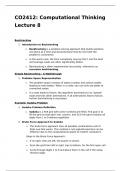Class notes
CO2412 Computational Thinking Lecture 8 Notes
- Course
- Institution
This document contains comprehensive notes from Lecture 8 of the CO2412 course on Computational Thinking. The lecture focuses on the concept of backtracking, a powerful problem-solving technique that incrementally builds solutions and backtracks when constraints are violated.
[Show more]



